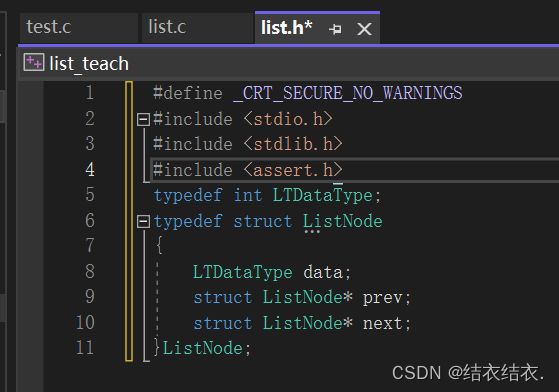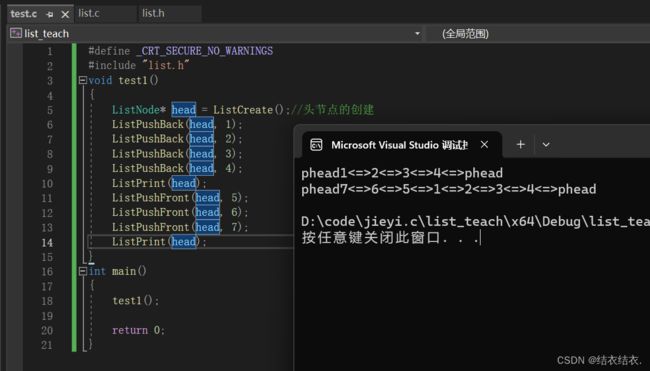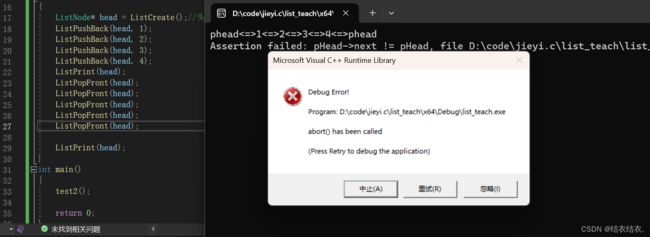数据结构——带头双向循环链表
呀哈喽,我是结衣。
前言
说到链表前面我们讲了单链表,但是链表可不止一种,要分类的话。链表可以分为带头或不带头,单向或双向,循环或者不循环,也就是说链表一共应该是有8种结构的,我们上次讲的链表就是不带头单向不循环链表。是链表中结构最简单的一种。

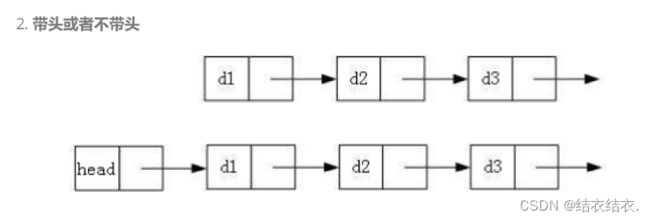

我们在来简单的解释一下两种链表把
1.无头单向非循环链表:结构简单,一般不会单独用来存数据。实际中更多是作为其他数据结
构的子结构,如哈希桶、图的邻接表等等。另外这种结构在笔试面试中出现很多。
2.带头双向循环链表:结构最复杂,一般用在单独存储数据。实际中使用的链表数据结构,都
是带头双向循环链表。另外这个结构虽然结构复杂,但是使用代码实现以后会发现结构会带来很多优势,实现反而简单了,后面我们代码实现了就知道了。
链表的实现
前边讲了那么多,最重要的还是要自己能把链表给实现了。下面就是实现的教学了。
创建不同文件
创建3个文件,分别要实现的功能为函数的声明,函数的定义,以及测试。目的是方便后续的增删查改。

结构体的创建
函数的声明
和单链表的函数声明差不多,都是头删,头插,尾插,尾删,打印等等…
我们先函数的声明先写完,后面再对他们挨个实现。
#define _CRT_SECURE_NO_WARNINGS
#include 写完函数声明接下来就是函数的实现了。
函数的实现
函数的实现写在list.c文件里面
我们先来讲头节点的创建。头节点是链表的头部且不会存储有效的数据。
头节点的创建
// 创建返回链表的头结点.
ListNode* ListCreate()
{
ListNode* head = (ListNode*)malloc(sizeof(ListNode));
head->data = -1;//可以随便存一个数据,在后续的操作中不会用到头节点的数据。
head->prev = head;
head->next = head;//prev和next都要指向本身,以实现循环。
return head;
}
写完头节点的创建,我们还要写一个打印函数,为了让后续的操作更加直观。
打印函数的实现
// 双向链表打印
void ListPrint(ListNode* pHead)
{
ListNode* cur = pHead->next;
printf("phead");
while (cur != pHead)
{
printf("%d<=>", cur->data);
cur = cur->next;
}
printf("phead\n");
}
cur!=pHead,目的是为了不打印头节点。
下面我们要写一个插入函数,才能直观的观察。所以我们接下来写尾插函数。
尾插函数的实现
// 双向链表尾插
void ListPushBack(ListNode* pHead, LTDataType x)
{
assert(pHead);
ListNode* newnode = CreatNode(x);
ListNode* cur = pHead;
ListNode* tail = pHead->prev;
tail->next = newnode;
newnode->prev = tail;
cur->prev = newnode;
newnode->next = cur;
}
写到尾插函数,我们又要写一个新节点的创建函数
ListNode* CreatNode(LTDataType x)
{
ListNode* newnode = (ListNode* )malloc(sizeof(ListNode));
newnode->data = x;
newnode->next = NULL;
newnode->prev = NULL;
return newnode;
}
欧克,写完了开始打印测试。
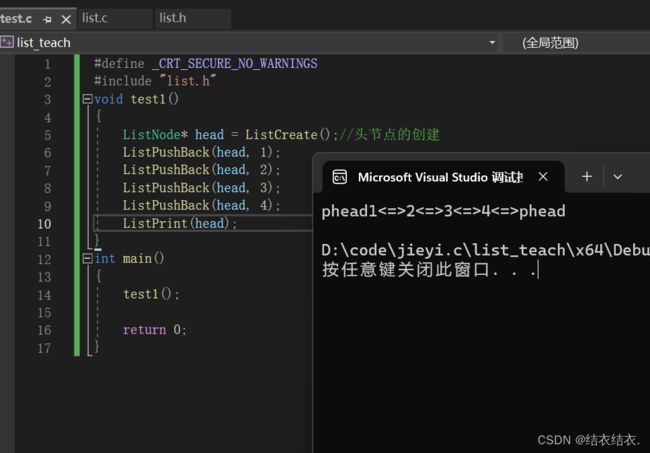
看上去是成功了,那就说明没什么问题了,有问题后续再检查。
头插函数的实现
// 双向链表头插
void ListPushFront(ListNode* pHead, LTDataType x)
{
assert(pHead);
ListNode* newnode = CreatNode(x);
ListNode* cur = pHead;
ListNode* next = pHead->next;
cur->next = newnode;
newnode->prev = cur;
newnode->next = next;
next->prev = newnode;
}
尾删函数的实现
删除后要记得free哦
// 双向链表尾删
void ListPopBack(ListNode* pHead)
{
assert(pHead->next != pHead);//当只有头节点时报错
ListNode* cur = pHead;
ListNode* tail = pHead->prev;
cur->prev = tail->prev;
tail->prev->next = cur;
free(tail);
tail = NULL;
}
测试
我们先删一些,再全部删完,再多删一个分别测试。


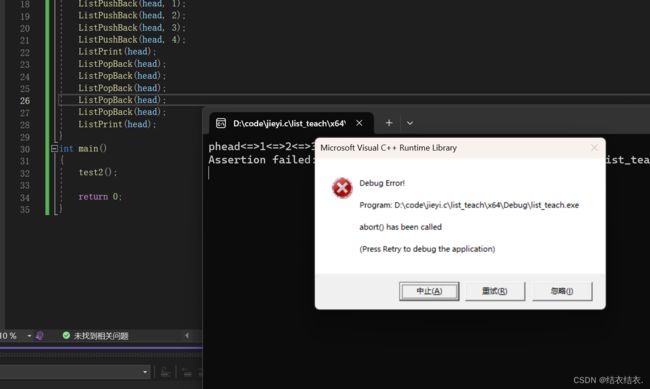
从这三张图片我们也可以看出来,代码是没有问题的。(在这里我悄悄改了一下打印函数的代码,看出来了吗?)
头删函数的实现
要记得free哦
// 双向链表头删
void ListPopFront(ListNode* pHead)
{
assert(pHead->next != pHead);
ListNode* first = pHead->next;
pHead->next = first->next;
first->next->prev = pHead;
free(first);
first = NULL;
}
销毁函数的实现
为什么就到销毁了呢?当然是想把剩下的指定位置的增删查改当成作业咯。
// 双向链表销毁
void ListDestory(ListNode* pHead)
{
ListNode* cur = pHead->next;
while (cur != pHead)
{
ListNode* next = cur->next;
free(cur);
cur = NULL;
cur = next;
}
//最后free pHead
free(pHead);
pHead = NULL;
}
就这样结束咯。
下面我们把代码都贴出来,(也包括查找函数和指定位置的增删查改函数)
代码
list.h
#define _CRT_SECURE_NO_WARNINGS
#include list.c
#define _CRT_SECURE_NO_WARNINGS
#include "list.h"
ListNode* CreatNode(LTDataType x)
{
ListNode* newnode = (ListNode* )malloc(sizeof(ListNode));
newnode->data = x;
newnode->next = NULL;
newnode->prev = NULL;
return newnode;
}
// 创建返回链表的头结点.
ListNode* ListCreate()
{
ListNode* head = (ListNode*)malloc(sizeof(ListNode));
head->data = -1;//可以随便存一个数据,在后续的操作中不会用到头节点的数据。
head->prev = head;
head->next = head;//prev和next都要指向本身,以实现循环。
return head;
}
// 双向链表打印
void ListPrint(ListNode* pHead)
{
ListNode* cur = pHead->next;
printf("phead<=>");
while (cur != pHead)
{
printf("%d<=>", cur->data);
cur = cur->next;
}
printf("phead\n");
}
// 双向链表尾插
void ListPushBack(ListNode* pHead, LTDataType x)
{
assert(pHead);
ListNode* newnode = CreatNode(x);
ListNode* cur = pHead;
ListNode* tail = pHead->prev;
tail->next = newnode;
newnode->prev = tail;
cur->prev = newnode;
newnode->next = cur;
}
// 双向链表头插
void ListPushFront(ListNode* pHead, LTDataType x)
{
assert(pHead);
ListNode* newnode = CreatNode(x);
ListNode* cur = pHead;
ListNode* next = pHead->next;
cur->next = newnode;
newnode->prev = cur;
newnode->next = next;
next->prev = newnode;
}
// 双向链表尾删
void ListPopBack(ListNode* pHead)
{
assert(pHead->next != pHead);//当只有头节点时报错
ListNode* cur = pHead;
ListNode* tail = pHead->prev;
cur->prev = tail->prev;
tail->prev->next = cur;
free(tail);
tail = NULL;
}
// 双向链表头删
void ListPopFront(ListNode* pHead)
{
assert(pHead->next != pHead);
ListNode* first = pHead->next;
pHead->next = first->next;
first->next->prev = pHead;
free(first);
first = NULL;
}
// 双向链表销毁
void ListDestory(ListNode* pHead)
{
ListNode* cur = pHead->next;
while (cur != pHead)
{
ListNode* next = cur->next;
free(cur);
cur = NULL;
cur = next;
}
//最后free pHead
free(pHead);
pHead = NULL;
}
// 双向链表查找
ListNode* ListFind(ListNode* pHead, LTDataType x)
{
ListNode* cur = pHead->next;
if (x == -1)
{
return NULL;
}
while (cur != pHead)
{
if (cur->data == x)
{
return cur;
}
cur = cur->next;
}
return NULL;
}
// 双向链表在pos的前面进行插入
void ListInsert(ListNode* pos, LTDataType x)
{
ListNode* newnode = CreateNode(x);
ListNode* prev = pos->prev;
prev->next = newnode;
newnode->prev = prev;
newnode->next = pos;
pos->prev = newnode;
}
// 双向链表删除pos位置的节点
void ListErase(ListNode* pos)
{
ListNode* prev = pos->prev;
ListNode* next = pos->next;
prev->next = next;
next->prev = prev;
free(pos);
pos = NULL;
}
test.c
#define _CRT_SECURE_NO_WARNINGS
#include "list.h"
void test1()
{
ListNode* head = ListCreate();//头节点的创建
ListPushBack(head, 1);
ListPushBack(head, 2);
ListPushBack(head, 3);
ListPushBack(head, 4);
ListPrint(head);
ListPushFront(head, 5);
ListPushFront(head, 6);
ListPushFront(head, 7);
ListPrint(head);
}void test2()
{
ListNode* head = ListCreate();//头节点的创建
ListPushBack(head, 1);
ListPushBack(head, 2);
ListPushBack(head, 3);
ListPushBack(head, 4);
ListPrint(head);
ListPopFront(head);
ListPopFront(head);
ListPopFront(head);
ListPopFront(head);
ListPopFront(head);
ListPrint(head);
}
int main()
{
test2();
return 0;
}
